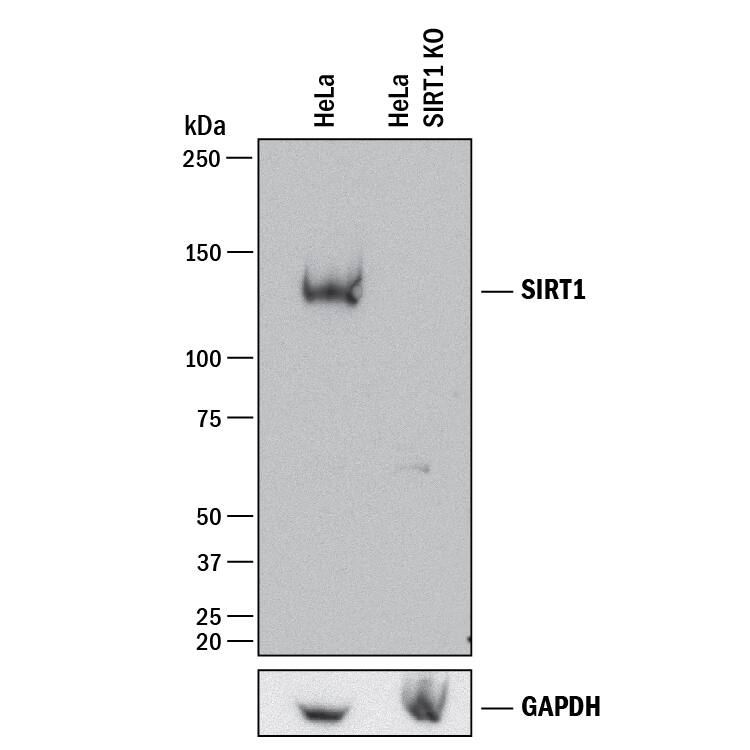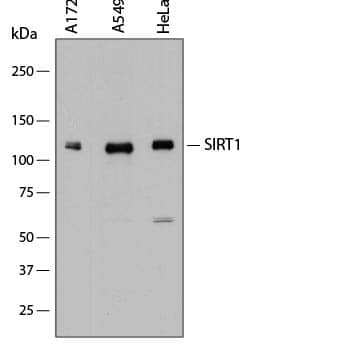Human Sirtuin 1/SIRT1 Antibody
R&D Systems, part of Bio-Techne | Catalog # AF7714

Key Product Details
Validated by
Species Reactivity
Validated:
Cited:
Applications
Validated:
Cited:
Label
Antibody Source
Product Specifications
Immunogen
Ala2-Ser747
Accession # Q96EB6
Specificity
Clonality
Host
Isotype
Scientific Data Images for Human Sirtuin 1/SIRT1 Antibody
Detection of Human Sirtuin 1/SIRT1 by Western Blot.
Western blot shows lysates of A172 human glioblastoma cell line, A549 human lung carcinoma cell line, and HeLa human cervical epithelial carcinoma cell line. PVDF membrane was probed with 0.2 µg/mL of Sheep Anti-Human Sirtuin 1/SIRT1 Antigen Affinity-purified Polyclonal Antibody (Catalog # AF7714) followed by HRP-conjugated Anti-Sheep IgG Secondary Antibody (Catalog # HAF016). A specific band was detected for Sirtuin 1/SIRT1 at approximately 120 kDa (as indicated). This experiment was conducted under reducing conditions and using Immunoblot Buffer Group 1.Detection of Sirtuin 1/SIRT1 in HepG2 Human Cell Line by Flow Cytometry.
HepG2 human hepatocellular carcinoma cell line was stained with Sheep Anti-Human Sirtuin 1/SIRT1 Antigen Affinity-purified Polyclonal Antibody (Catalog # AF7714, filled histogram) or isotype control antibody (Catalog # 5-001-A, open histogram), followed by Allophycocyanin-conjugated Anti-Sheep IgG Secondary Antibody (Catalog # F0127). To facilitate intracellular staining, cells were fixed and permeabilized with FlowX FoxP3 Fixation & Permeabilization Buffer Kit (Catalog # FC012). View our protocol for Staining Intracellular Molecules.Western Blot Shows Human Sirtuin 1/SIRT1 Specificity by Using Knockout Cell Line.
Western blot shows lysates of HeLa human cervical epithelial carcinoma parental cell line and SIRT1 knockout HeLa cell line (KO). PVDF membrane was probed with 0.2 µg/mL of Sheep Anti-Human Sirtuin 1/SIRT1 Antigen Affinity-purified Polyclonal Antibody (Catalog # AF7714) followed by HRP-conjugated Anti-Sheep IgG Secondary Antibody (Catalog # HAF016). A specific band was detected for Sirtuin 1/SIRT1 at approximately 120 kDa (as indicated) in the parental HeLa cell line, but is not detectable in knockout HeLa cell line. GAPDH (Catalog # AF5718) is shown as a loading control. This experiment was conducted under reducing conditions and using Immunoblot Buffer Group 1.Applications for Human Sirtuin 1/SIRT1 Antibody
CyTOF-ready
Flow Cytometry
Sample: HepG2 human hepatocellular carcinoma cell line fixed and permeabilized with FlowX FoxP3 Fixation & Permeabilization Buffer Kit
Knockout Validated
Western Blot
Sample: A172 human glioblastoma cell line, A549 human lung carcinoma cell line, and HeLa human cervical epithelial carcinoma cell line
Reviewed Applications
Read 1 review rated 5 using AF7714 in the following applications:
Formulation, Preparation, and Storage
Purification
Reconstitution
Formulation
Shipping
Stability & Storage
- 12 months from date of receipt, -20 to -70 °C as supplied.
- 1 month, 2 to 8 °C under sterile conditions after reconstitution.
- 6 months, -20 to -70 °C under sterile conditions after reconstitution.
Background: Sirtuin 1/SIRT1
SIRT1 (SIR2-like protein 1; also NAD-dependent protein deacetylase sirtuin-1 and hSIR2) is a class I member of the sirtuin family of enzymes. Although its predicted MW is 81 kDa, it runs anomalously at 110-120 kDa in SDS-PAGE. It is a widely expressed nuclear protein that participates in the deacetylation of multiple proteins, including p300, p53, LKB1 and histone H1. Functionally, this has the effect of promoting heterochromatin formation, cell survival and resistance to oxidative stress. Metabolically, SIRT1 induces insulin secretion, inhibits glycolysis and suppresses fatty acid synthesis. Human SIRT1 is 747 amino acids (aa) in length. It possesses two NLS's (aa 32-39 and 223-230), an NES (aa 138-145), and a sertuin-type deacetylase domain (aa 241-495) that contains an NAD and Zn binding motif. There are at least 12 utilized Ser/Thr phosphorylation sites, plus two nitrosylated Cys and one acetylated Ala. There are also four potential isoform variants. One is 95 kDa in size and shows a deletion of aa 454-639, a second is 17 kDa in size and contains a 16 aa substitution for aa 149-747, and a third contains an alternative start site at Met296. SIRT1 is also known to undergo proteolysis by cathepsin B at Val533Ser534, generating a fourth, C-terminally truncated 75 kDa isoform. Full-length SIRT1 is suggested to form trimers, while the 17 kDa isoform appears to form dimers. Over aa 2-747, human and mouse SIRT1 share 86% aa sequence identity.
Long Name
Alternate Names
Gene Symbol
UniProt
Additional Sirtuin 1/SIRT1 Products
Product Documents for Human Sirtuin 1/SIRT1 Antibody
Product Specific Notices for Human Sirtuin 1/SIRT1 Antibody
For research use only


